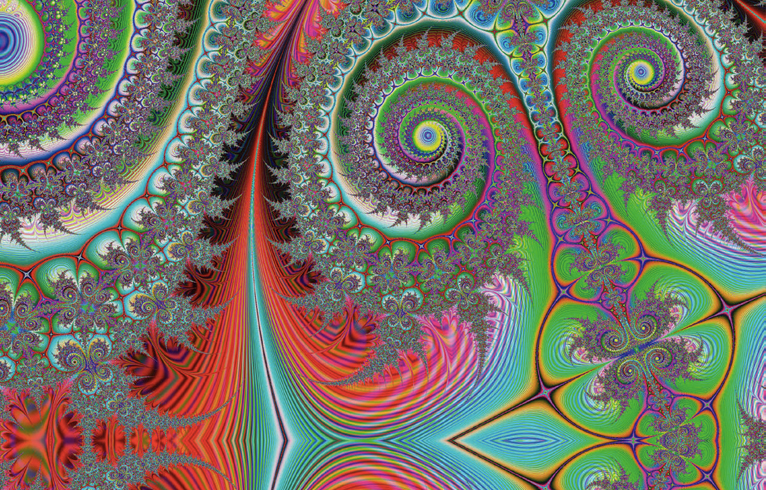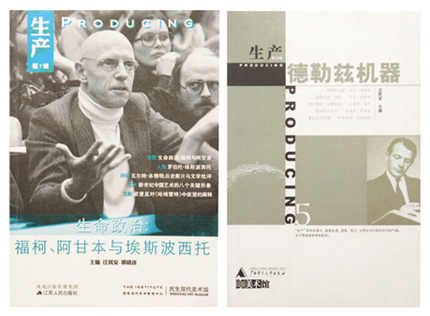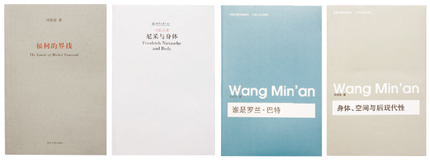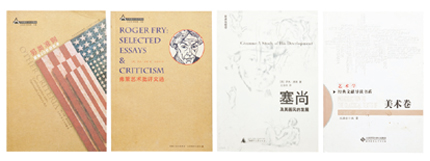INTERPRETING THEORY: TWO MODELS FOR IMPORTATION
| May 11, 2012 | Post In LEAP 14

THE 30 SHORT years since the advent of Chinese contemporary art have also seen wave upon wave of interest in Western theory, beginning with the popularity of existentialism in the 1980s. The impact of these trends is readily apparent within artworks such as Zhong Ming’s He Is Himself—Sartre. Later, following the entrée of postmodern theory, Michel Foucault, Jacques Derrida, and Gilles Deleuze became frequently cited in critical essays. The most recent trend includes Giorgio Agamben, Alain Badiou, Jacques Rancière, and Slavoj Žižek, as well as Boris Groys and Hans Belting, among others. These intellectuals— who have similarly become popular in academic circles around the world— are not unfamiliar to those within China’s educational institutions, but few scholars have engaged in specialized research and translation. In contrast, the wider public has been more active in the translation process through online platforms such as Douban.com, webzines such as Mister Po, and energetic translators such as Wang Liqiu; these efforts have been supplemented by more dispersed and cloud-driven translation projects, as well as “fault-finding” translation-critique blogs such as Qiaonasen. Within art circles, translation has been more selective and targeted, but few of these rapid-fire translations undergo rigorous editorial scrutiny and formal publication.
In one noteworthy incident, Groys— who has become extremely popular in China— received a much more enthusiastic reception than his co-curator, Jens Hoffmann, at the press conference of the 2012 Shanghai Biennale. There has been no systematic translation of Groys’ writings in mainland China, but due to the piecemeal efforts of a few translators— including a widely-read edition of his essay, “The Weak Universalism”— his popularity within Chinese art circles has greatly outstripped Hoffmann’s. Of course, some complain that the process of introduction through translation lacks critical perspective. In addition to the inconsistent quality of the translations, the process of choosing which works of a certain theorist to translate is also irregular, with the most important and relevant texts sometimes left untranslated. As for why the theories and theorists of so-called French radical philosophy and the New Left have become so popular in the art world, one explanation is that artists largely incline to the Left, especially since the advent of modern art. Artists, fulfilling their role as the cultural vanguard, must criticize and repudiate. To rejuvenate people from states of complacency, art is duty-bound to push the envelope in the realms of both feelings and ideas; the transformative efforts of artists go hand-in-hand with radical politics. However, some have pointed out the problems raised by imposing these theories upon the Chinese context. In interviews with LEAP, Wang Min’an and Shen Yubing— two scholars with close links to translation and the art world— shared their views.

THE POWER OF TRENDS
WANG MIN’AN
Wang Min’an holds a PhD in literature and is currently a professor at the Research Institute of Foreign Literature at Beijing Foreign Studies University. His main research interests include critical theory, cultural studies, modern art, and literature.
“In the 1980s, everybody was reading philosophy. It was not only artists, but theorists and scientists as well. People read philosophy because it was a social trend in the 1980s, but today, they read it out of genuine interest. I think today it is mostly artists who are reading philosophy.”
Wang Min’an says that interest in Western philosophy and theory had already grown strong before he started university in 1988. At that time, Freud, Nietzsche, and Sartre were popular. After he started university, those thinkers gradually gave way to postmodern philosophers such as Foucault, Derrida, and Lacan. But even then, few postmodern works had been translated, in contrast to the excited and chaotic translation scene of the 1980s.
After completing his master’s degree in 1995, Wang Min’an began translating short essays, including papers by Derrida and Roland Barthes. During his doctoral studies, he collaborated with classmates to translate and edit Postmodern Philosophical Discourse.
“I really may have been the earliest link between the theory world and the art world. First of all, these things I was reading, like Roland Barthes, Foucault, and Derrida, often touched on art. I read Derrida’s discussion of Van Gogh in The Truth in Painting very early on. That book has still not been translated into Chinese. As I started reading more and more, I learned that all foreign philosophers talk about art. Not only do they understand contemporary art, but also cinema, music, architecture— they understand all of it. I was also interested in this aspect.” After moving to Beijing, Wang Min’an met curator Huang Du and gradually came into contact with the art world. He soon published his first exhibition critique in Avant-Garde Today. At the time, Beijing’s art scene was small, and Wang quickly became a familiar face. Before long, Wang’s translations of Derrida, Barthes, Deleuze, and other French philosophers became well known.
Chinese interest in Western theory has largely tracked trends in international intellectual circles, and hot topics among artists are no different. Wang Min’an says that nobody in China was talking about Agamben when Producing magazine— of which Wang was editor-in-chief— devoted a special issue to the theorist in 2005. Then, in 2006, he published an Agamben essay in Dushu. He also began translating Badiou just as that philosopher was becoming popular overseas. But there remained an evident lag between domestic and international trends: “Agamben was popular in the United States about ten years earlier than in China. His book Homo Sacer was published by Stanford in 1996 or 97. He was very big in the United States before 2000. We truly first introduced that book in 2004, and I translated a few essays. There was a gap of at least five or six years.”
According to Wang Min’an, a major reason for the popularity of these theorists was that they were important interpreters of the previous generation of philosophers. For example, Agamben served this role for Foucault, and Badiou and Žižek did the same for Lacan. All of the French theory from the 1960s was interconnected. “There are fashions in academia as well, such as Foucault, Derrida, and Deleuze. They got big in the 1960s and 70s, and they stayed popular for more than 30 years. After those 30 years, they had been completely digested. American academia had become extremely versed in these thinkers, and they no longer seemed fresh. American academia, like the art world, is always looking for new stars. The presently popular philosophers— Agamben, Badiou, Žižek— are the students of that previous generation. From the perspectives of importance, originality, and historical status, they cannot be compared to their predecessors. The United States does not contribute any great masters, but all of the great masters must make it to the United States. Once you have been recognized in the United States, the whole world recognizes you. Their criticism system is strong, and it is genuinely capable of discovering what is truly good. We do not have this capacity for judgment in China, and it is not what we say that counts. When we introduced Agamben, it was not because we had read his work and then made a decision, but rather because he was already really big in the United States. To a great degree, the whole intellectual scene— ten years ago it was Foucault and Derrida, then Deleuze, and now a few years later, Agamben, Badiou, and Rancière— largely follows institutional trends.”
However, there are few translations of these texts in China today. Some individual essays circulate online, but relative to their authors’ overall output, they are very few in number. Only one or two books by even the most popular theorists have been formally published in translation. “In fact, very few books are translated, but the copyrights are being purchased. For example, I contacted Beijing University Press about Agamben’s books, and they had already purchased four or five books.”

“To tell the truth, I do not think that artists really need to read theory. Really good artists or big artists are themselves philosophers, and they do not at all need to go read philosophy. Frankly speaking, I think there are only a few Chinese artists who really understand these issues. Wang Jianwei may be someone with a relatively deep understanding. He is the only artist I have spoken to who can genuinely discuss the ins and outs of theory. He more or less understands Žižek just as we do in academia,” says Wang Min’an. But many of the artists— especially installation and video artists— he has encountered in the past two years have wanted to discuss philosophy with him. Five years ago, no artists wanted to talk about philosophy, but suddenly in the last few years, everyone does. First it was Foucault and Deleuze; now it is Agamben and Rancière. “They seem to be interested in this, and their interest is very intense.”
ESTABLISHING ART HISTORY AS AN ACADEMIC DISCIPLINE
SHEN YUBING
Professor at Zhejiang University’s College of Media and International Culture, Shen Yubing specializes in modern Western aesthetics, modern art history, and the history of ideas. He has authored Art Criticism in the Twentieth Century, and translated Roger Fry’s Cézanne: A Study of His Development and Clement Greenberg’s Art and Culture: Critical Essays. He has also served as the editor of the book series “Translations in Concepts in Art,” “Translations in Art Theory and Criticism,” and “Essential Readings in Art.”
“As a scholar of art history, the biggest challenge that I face is the shallow academic foundation of this field, in particular its lack of documentation.”
A theorist who toils at a distance from the contemporary art scene, Shen Yubing is content to be left to his work— the monumental task of building for China the foundations of what will become the discipline of art history. The period on which his research and writing focuses begins with the birth of modernism and extends all the way to the present day. It is his opinion that the digestion and absorption of the last century of Western modernism in China have been both crude and impetuous.
From the latter half of the nineteenth century to the middle of the twentieth century, the West saw nearly 100 years of not only art movements, but also rich histories of criticism, theory, and aesthetics develop. In China, engagement with modernist thought is recent and piecemeal. Shen Yubing’s goal is to assist art research in China to make up for what it has missed. Achievement of this goal requires dedicated long-term research and translation of crucial texts from the West, which is what Shen and his colleagues are collaboratively engaged in at the moment.
In jest some people call Shen Yubing a “bookshelf scholar,” due to the fact that he has yet to actively participate in the thriving development of Chinese contemporary art. Yet via his translations of Fry’s Cezanne: A Study of His Development, Greenberg’s Art and Culture: Critical Essays, and Leo Steinberg’s Other Criteria, and in his foreword to Essential Readings in Art: Fine Art Volume, Shen Yubing clearly states his position: “We must engage in a long-term process of translating, introducing, understanding, and incorporating Western academic writings about art; only in this way can we avoid oversimplifying their ideas. To do this, we cannot rely on a couple of survey articles. If these translations are not comprehensive, many will be nothing more than generalized introductions.”
In the same volume, Shen Yubing outlined his conception of Western art history, art theory, and criticism, which he separated into four main areas: “Iconography and the Social History of Art”; “Psychoanalysis, Theories on Style, and Theories of Visual Perception”; “Formalism and Modernism”; and “Avant-garde Art and Postmodernism.” The texts that Shen selected for the series were by art historians such as Heinrich Wölfflin, Fry, Erwin Panofsky, Meyer Shapiro, Ernst Gombrich, T. J . Clark, and Benjamin Buchloh, while the critics and theorists chosen included Greenberg, Steinberg, Michael Fried, Rosalind Krauss, Hal Foster, and Yve-Alain Bois.
Shen Yubing advocates the modernist social division of labor in art theory and practice— the study of art history is an academic discipline, while artistic work is about creation. The two are separate. An art historian’s work is rooted in historiography; he doesn’t have a duty to direct art practice. Nevertheless, Shen does not deny that combining theory and practice is a veritable method for practice, and one not without reason:

“According to the ancient Greeks, the science of theoretical research was considered philosophy, the study of creation was considered poetry; philosophy was theory, and creation was practice.” In contemporary art, theory and practice are becoming increasingly intertwined. In the West, there are universities who offer a PhD in poetics, to educate people into becoming practicing artists, not art historians or aestheticians. The conventional wisdom used to be that artists don’t need a doctorate, that an MA was enough. But in some universities in the West, contemporary art theory and practice are being more closely meshed together. This is the trend of the moment. It is hard to say now whether it is good or bad; we might need to wait another 20 years.
“What I object to is this: those people turn theory into practice (such as those who turn a research paper into a writing experiment), in turn push practice closer and closer to theoretical methodology, and claim that this is the only viable approach, the approach China most needs to adopt. This way of thinking ignores the division of labor, and is typical of postmodernism.
“The way I see it, what China needs most is to proceed according to that division of labor. Everyone should continue doing what it is we all do, and slowly digest the last 100 years of history in Western modernism. There is no need to rush. The establishment of certain core principles of modernist thought cannot be skipped. Jumping straight into postmodernism won’t work. Acting in haste now will only pit us in a never-ending, pre-modernist cycle.”
Shen Yubing strongly disagrees with the view that modern art history is now passé, and contemporary art is all that we should care about. He believes that the flow of theoretical development cannot be artificially severed. Without the last century of modernist heritage as context, there can be no such thing as contemporary art. As an example, he points out that if there were no Society of Independent Artists organizing salon exhibitions in Paris, then there could not have been its counterpart in New York, nor the environment for Marcel Duchamp’s Fountain to spring from.
In their Western iterations, pre-modern, modern, and postmodern seem to have occurred in a clear, linear progression. The appearances of anti-modern and postmodern movements are predicated on the existence of a well-developed modernism. But in China, as Shen Yubing observes, the pre-modern, modern, and postmodern are all mixed together. He says, “China still has many things that are pre-modern, even feudal. But aspects like the management at some private enterprises are modern. And then there are the cutting edge theories, which are quite postmodern. All of these ideas and thoughts are mixed together, which creates a very complicated social and academic environment.”
Shen Yubing reminds us of the dangers of “sharism,” which leads people to believe that whatever is contemporary must also be avant-garde. But they are not aware that many artists who are active on the contemporary scene are themselves stuck in pre-modern modes of thought. Academic research and artistic creation are interrelated; advancements in one lead to progress in the other. An artist does not necessarily have to be well-versed in theory, or have research credentials, but he should have a level of intelligence and understanding that is concurrent with the times in which he creates art. And this intelligence greatly benefits from collaboration between theorists and artists— even those who do not directly participate in the creation of art can still shape its development.

